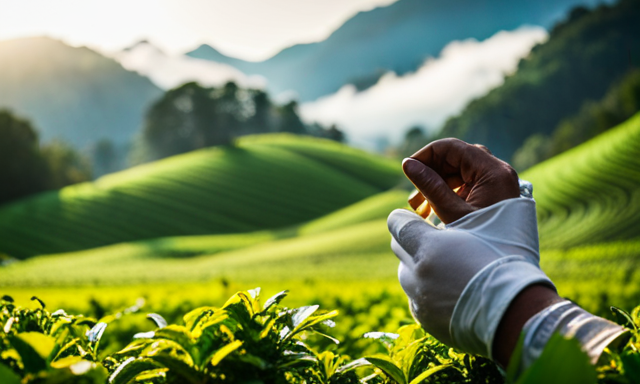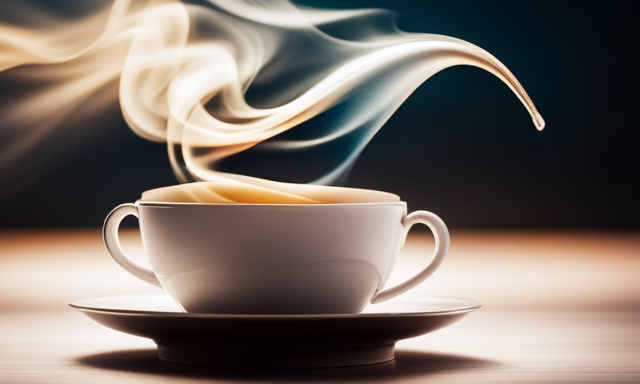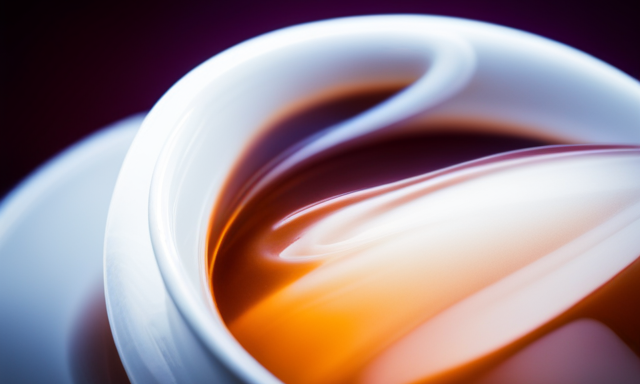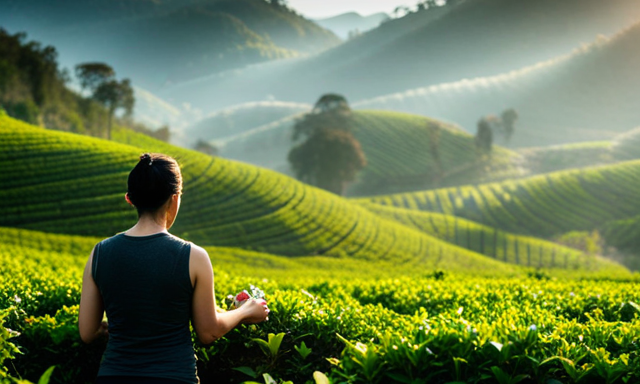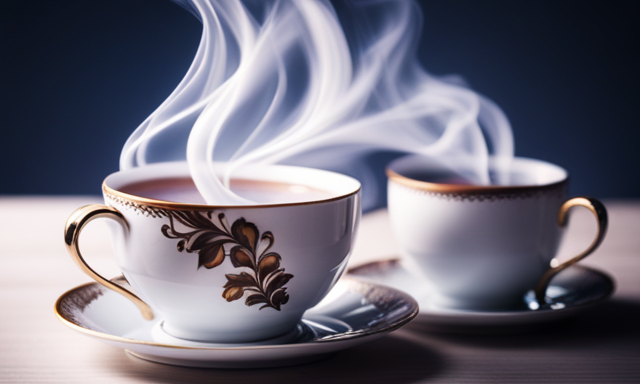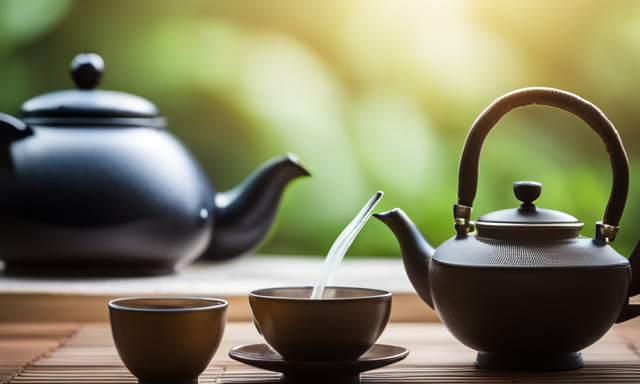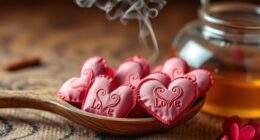I will always remember the initial moment I tasted oolong tea. It felt like a harmonious blend of flavors waltzing on my palate, impressing me with its intricacy and depth.
Oolong tea, made from the leaves of the Camellia sinensis plant, is a traditional Chinese tea that falls somewhere between green and black tea in terms of oxidation. It is renowned for its delicate balance of floral and fruity notes, coupled with a subtle hint of earthiness.
The process of making oolong tea is a true art form, involving withering, rolling, oxidation, and firing. Each step is carefully executed to create a tea that is both aromatic and flavorful.
In this article, we will explore the origins of oolong tea, the key ingredients that give it its unique character, and the health benefits it offers. So grab a cup, sit back, and join me on this journey into the world of oolong tea.
Key Takeaways
- Oolong tea is made from the leaves of the Camellia sinensis plant.
- The tea falls between green and black tea in terms of oxidation.
- Oolong tea is known for its delicate balance of floral and fruity notes.
- The tea-making process includes withering, rolling, oxidation, and firing.
Introduction to Oolong Tea
Oolong tea is a unique type of tea that falls between green and black tea in terms of oxidation level. It is made from the leaves of the Camellia sinensis plant, the same plant that is used to make other types of tea. The leaves are partially oxidized, which gives oolong tea its distinct flavor and aroma.
Oolong tea is known for its numerous health benefits, including boosting metabolism, reducing the risk of heart disease, and improving brain function. With its delicate and complex taste, oolong tea is a popular choice among tea enthusiasts.
Now, let’s delve into the origins of oolong tea and discover its fascinating history.
Origins of Oolong Tea
Originating in the Fujian province of China, this unique brew combines the qualities of black and green varieties, captivating tea enthusiasts worldwide.
- Oolong tea has a long history that dates back over 400 years.
- The Fujian province is renowned for its ideal climate and fertile soil, which provide the perfect conditions for growing oolong tea.
- The tea leaves used to make oolong are carefully handpicked, ensuring only the highest quality leaves are selected.
- Cultivation of oolong tea involves meticulous attention to detail, including proper pruning, shading, and harvesting at the optimal time.
Oolong tea’s origins and cultivation practices contribute to its distinct flavor and aroma. In the subsequent section on processing oolong tea, we will explore the intricate steps involved in bringing out the tea’s unique characteristics.
Processing Oolong Tea
Crafted by skilled artisans, the delicate leaves of this specialty brew undergo a meticulous process that transforms them into a fragrant and flavorful infusion.
Oolong tea processing involves several steps that contribute to its unique taste and aroma. After plucking, the leaves are withered under the sun, allowing them to lose moisture and become more pliable.
Next, the leaves are partially oxidized, which gives oolong tea its characteristic flavor profile, ranging from light and floral to bold and fruity. The oxidation process is carefully controlled to achieve the desired level of oxidation.
Following oxidation, the leaves are gently rolled or twisted, shaping them into tight curls or long, wiry strands. This step enhances the tea’s aroma and flavor.
Finally, the leaves are fired to halt the oxidation and preserve their quality.
With the oolong tea production process complete, we can now explore the different types of oolong tea.
Types of Oolong Tea
To fully appreciate the variety of oolong tea, you’ll want to explore the different types available. Each type offers unique flavors and aromas that cater to different palates and preferences.
Did you know that there are over 100 different types of oolong tea? These types range from lightly oxidized to heavily oxidized, allowing for a wide range of taste experiences.
Some popular types of oolong tea include Tie Guan Yin, Da Hong Pao, and Oriental Beauty. Each type has its own distinct processing methods and characteristics, resulting in varying flavors and appearances.
Oolong tea is known for its many health benefits. It can promote weight loss, improve heart health, and boost brain function. So, whether you prefer a floral and light oolong or a rich and roasted one, there is a type of oolong tea that will suit your taste.
Now, let’s delve into the key ingredients in oolong tea.
Key Ingredients in Oolong Tea
Experience the tantalizing blend of flavors and aromas that come together in every sip of this exquisite beverage, as the key ingredients in oolong tea captivate your senses and leave you craving for more.
Oolong tea is made from the Camellia sinensis plant, and its unique flavor profile is a result of the careful processing of its leaves. Here are the key ingredients that make oolong tea a delightful and healthful choice:
- Polyphenols: These powerful antioxidants help boost the immune system and reduce the risk of chronic diseases.
- Caffeine: Oolong tea contains a moderate amount of caffeine, providing a gentle energy boost.
- Theanine: This amino acid promotes relaxation and mental clarity, creating a soothing effect.
- Vitamins and minerals: Oolong tea is rich in vitamins A, C, and E, as well as essential minerals like potassium and calcium.
- Flavonoids: These compounds contribute to the tea’s distinct taste and offer potential health benefits.
As we delve into the flavor profiles of oolong tea, you’ll discover the exquisite nuances that make each variety truly unique.
Flavor Profiles of Oolong Tea
Oolong Tea is renowned for its complex and nuanced taste, offering a delightful experience for tea enthusiasts. One of the distinctive characteristics of Oolong Tea is its floral notes, which add a fragrant and delicate touch to the brew. These floral undertones can vary from tea to tea, with some varieties showcasing hints of orchid or jasmine.
Additionally, Oolong Tea often exhibits roasted flavors, which lend a pleasant depth and richness to the overall taste. The level of roast can range from light to dark, resulting in a spectrum of flavors that cater to different preferences.
As we transition to exploring the health benefits of Oolong Tea, it becomes clear that this tea not only pleases the palate but also offers numerous advantages for overall well-being.
Health Benefits of Oolong Tea
Indulging in a cup of this aromatic brew promises to be a boon for your well-being, with a myriad of health benefits waiting to be savored.
Oolong tea, known for its unique flavor and rich aroma, offers numerous advantages for those seeking to improve their health. One of the most popular benefits of oolong tea is its potential for aiding in weight loss. Studies have shown that oolong tea can increase metabolism and help burn fat more effectively, making it an excellent addition to any weight loss regimen.
Additionally, this tea contains polyphenols and antioxidants that can support a healthy immune system and reduce the risk of chronic diseases.
Transitioning into the subsequent section about brewing and serving oolong tea, let’s explore how to make the perfect cup that maximizes its health benefits.
Brewing and Serving Oolong Tea
Get ready to elevate your tea game with the perfect brewing and serving techniques for oolong tea that will leave you craving for more.
When it comes to brewing oolong tea, it’s important to find the right balance between temperature and steeping time. The ideal water temperature for oolong tea is around 180°F to 200°F, and it should be steeped for 3 to 5 minutes. This will ensure that you extract the full flavor and aroma of the tea leaves.
To enhance your oolong tea experience, consider using tea accessories such as a gaiwan or a tea infuser to steep the leaves. These tools allow for better control and extraction of flavors.
Now, let’s dive into the next section about oolong tea in culinary applications and discover its versatility in the kitchen.
Oolong Tea in Culinary Applications
Explore the enchanting world of oolong tea as it dances gracefully in the culinary realm, adding a touch of elegance and depth to your dishes.
Oolong tea is not only a delicious beverage, but it also has a variety of culinary uses. Its unique flavor profile, which falls somewhere between black and green tea, makes it a versatile ingredient in both sweet and savory recipes.
From oolong-infused desserts like ice creams and custards to savory dishes like braised meats and marinades, this tea can elevate the taste and aroma of your creations. The delicate floral and fruity notes of oolong tea can bring a subtle complexity to dishes, creating a truly memorable dining experience.
So, let’s delve into the world of oolong tea recipes and discover the endless possibilities it offers.
Next, we will explore the conclusion and final thoughts on oolong tea.
Conclusion and Final Thoughts on Oolong Tea
In conclusion, Oolong Tea has proven to be a versatile ingredient in culinary applications. Its unique flavor profile adds depth to dishes, whether used as a marinade, broth, or even in desserts. I have personally enjoyed experimenting with Oolong Tea in my own cooking, and it has never failed to impress.
Moving on to the final thoughts on Oolong Tea, it is important to note its relevance to weight loss. Oolong Tea has been found to aid in weight management by boosting metabolism and promoting fat oxidation. Incorporating it into a balanced diet and exercise regime can potentially enhance weight loss efforts.
Furthermore, Oolong Tea has also been linked to improved mental health. The combination of caffeine and L-theanine found in Oolong Tea can promote relaxation and mental clarity, reducing stress and anxiety.
Overall, Oolong Tea is not just a delicious beverage, but also a valuable addition to a healthy lifestyle, offering benefits for both physical and mental well-being.
| Benefit of Oolong Tea | Relevance |
|---|---|
| Weight Loss | High |
| Mental Health | High |
| Antioxidant | Medium |
| Heart Health | Medium |
| Digestive Health | Low |
Frequently Asked Questions
How long does it take to brew a perfect cup of oolong tea?
To brew a perfect cup of oolong tea, it takes about 3-5 minutes at an optimal temperature of 190-200°F. This ensures the tea leaves release their flavors, resulting in a balanced and aromatic infusion.
Can oolong tea be combined with other herbs or flavors to enhance its taste?
Oh, the magical possibilities of herbal oolong combinations! With a dash of creativity, flavors like jasmine, ginseng, or even lavender can harmonize with oolong tea, elevating its taste to extraordinary heights.
Are there any specific tea ceremonies or rituals associated with oolong tea?
Oolong tea, with its rich cultural significance, is often enjoyed in traditional tea ceremonies. These ceremonies vary across different cultures, but they all emphasize the importance of mindfulness, appreciation, and the art of tea preparation.
How does the caffeine content in oolong tea compare to other types of tea?
Compared to other teas, oolong tea contains moderate levels of caffeine. It offers various health benefits like boosting metabolism and promoting heart health. Embrace the energizing effects of oolong tea while enjoying its numerous advantages.
Can oolong tea be consumed by individuals with specific dietary restrictions, such as gluten-free or vegan diets?
Oolong tea is a gluten-free and vegan-friendly beverage, making it suitable for individuals with dietary restrictions. It is made from the leaves of the Camellia sinensis plant and offers a unique flavor profile.
Conclusion
In conclusion, oolong tea is a remarkable beverage that offers a delightful balance of flavors and a multitude of health benefits. Its origins can be traced back centuries. Oolong tea is made through a unique processing method that sets it apart from other teas. It contains key ingredients like polyphenols and catechins, which promote overall health and wellness. Oolong tea can be enjoyed on its own or incorporated into culinary creations. It is a versatile and flavorful addition to any routine. So go ahead, indulge in a cup of oolong tea and experience the euphoria of its exquisite taste and countless benefits.

